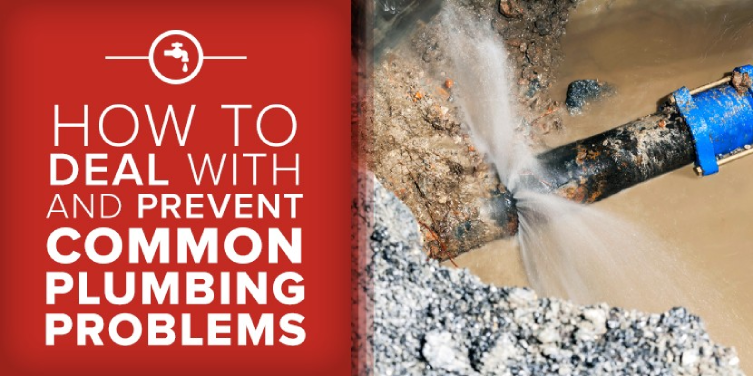
Have you had to live in your home without water? It is difficult and affects many of your daily activities. No water or problems with your plumbing system can mean you need to call in a professional to get your home in working order again, and if that’s the case, give us a call and we’ll be happy to help you out. But we’d like you to know about some of the common plumbing issues that you can take care of yourself. If you can get in the habit of following a simple maintenance schedule to catch some of those minor fix-ups before they become major repairs, you’ll be in an even better position to avoid costly home repairs and the inconvenience of no running water.
Plumbing Maintenance Tips
The basic task for any maintenance schedule is the inspection. Even though you are using your water every day for a variety of things, you won’t notice some of those issues that start as small leaks or corroded pipes and fittings. You’ll also want to test the responsiveness of your plumbing and do a bit of cleaning to keep everything in good shape. Go through this Check-Test-Clean routine every 3-4 months.
Here are some tips to help you with your do-it-yourself plumbing inspection and maintenance:
Check Your Pipes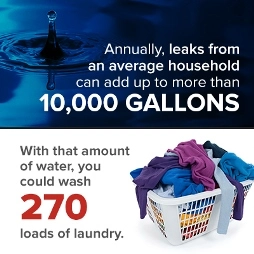
Examine all exposed pipes under sinks and behind toilets for signs of moisture and corrosion on brass and copper fittings. Condensation on cold metal pipes is normal on humid days, so if you detect dampness on metal pipes on hot days, make a note to check again when your home is cooler. Corrosion is created by moisture on metals, so it could indicate a slow leak, but it could also be a result of constantly “sweating” pipes from condensation. Heavily corroded fittings should be replaced, even if it’s just from condensation, and keep a watch on those areas that show a lot of corrosion to see if there is an actual leak.
Most leaks are easily fixed by homeowners by replacing shower heads, fixture seals, and valves. Leaks from an average household can add up to more than 10,000 gallons of water each year. That’s about the amount of water you’d need to wash 270 loads of laundry, so don’t ignore those little drips because they can really add up.
Test Your Faucets and Water Pressure
Go to each of your faucets and turn on the hot and cold water independently to monitor the water pressure. Different faucet styles, like low-flow designs and fixtures with specific purposes, will produce slightly different water pressure, but judge accordingly as you test each source of water. They should all have a steady flow without fluctuating, even when opening and closing the tap.
As you’re testing the water pressure, also pay attention to how the drain is working. Slow drains could indicate a blockage building up, and it’s always easier to fix a clogged drain before it has gotten to the point of complete blockage. Don’t forget about testing the toilet drain. When you flush the toilet, check the base for any signs of leaking, which would likely be an issue with the wax seal.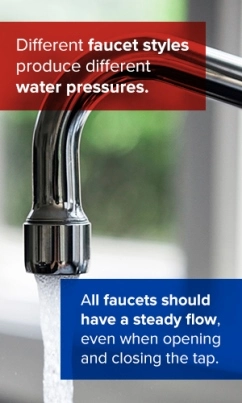
Clean Out Buildup
Remove aerators on faucets and shower heads to remove the buildup of hard water deposits that can slow and distort the water flow. Clean these parts by letting them sit in a bowl of vinegar or calcium and lime remover.
Call in the Pros
Some homeowners are just fine doing these fairly easy maintenance tasks, but they still take time, and some people would rather have a trained eye look at their plumbing. Our professionals at Mr. Rooter Plumbing in Oneida will be able to detect some issues you may not notice and use tools and products to provide you with thorough plumbing system maintenance and cleaning.
DIY Plumbing Mistakes You Want to Avoid
With the abundance of information available on the Internet, especially some of the professional “how-to” videos that show you the step-by-step process of common household tasks, you can be quite successful in numerous fixes to do with various parts of your house. Taking on the maintenance and repairs of your home can make you feel proud and accomplished as a homeowner, but there are a number of things you should avoid related to the plumbing of your home that can make you feel foolish and embarrassed when you need to call in a professional to fix a problem you created or made bigger.
These plumbing mistakes aren’t specifically to do with plumbing problems that should have been left to a licensed plumber (we’ll let you know about those next), but they are about poor planning of renovations or new setups and inappropriate actions.
1. Flushing the wrong things down the toilet.
More common in a household with children, this mistake may cause a blockage that can’t be removed without the services of a plumber. We’ve had some calls that have required the removal of the toilet and replacement of pipes — a time-consuming and costly mistake. As yucky as it may be to remove something from the toilet, don’t just hope that it will just pass through.
If it’s something the toilet wasn’t designed for a load of toilet paper your toilet and plumbing weren’t designed to handle, take the path of least resistance and fish it out! Unfortunately, children are sometimes the ones doing the flushing, and you realize the toilet is clogged only after the damage has been done. If you can’t bring it up with a plunger, call in a professional who will solve your problem the easiest way.
2. Washing inappropriate materials down the drain.
Sinks and bathtubs sometimes get used for waste disposal in the wrong way. The most common types of materials that get carelessly washed down the drain are construction materials like cement compound and other hardeners. Some people do this thinking it will just get washed away with the water, but unless it’s a very small amount, you will likely be faced with a clogged drain that will only be remedied by replacing all the drains and pipes effected.
3. Breaking faucets or fittings by using too much force.
That dripping faucet or leaking drain under your sink doesn’t need excessive force to be fixed. Dripping faucets are rarely fixed by tightening the handle more than usual, and a leaking pipe isn’t best looked after by cranking the wrench on the fitting. Sometimes dripping is due to wear and tear, and a replacement, new seal or other minor part may do the job.
4. Taking something apart and forgetting how to put it back together.
You may think that taking a faucet apart or attaching your new dishwasher to existing plumbing is an easy enough task, but you may run into problems if there are too many components to remember, or if that new dishwasher doesn’t have the same hookups as your old one. Unless you’ve got experience working with plumbing components, this may be a job where you want to enlist the help of a more knowledgeable friend or just pay for the services of a professional.
5. Having too many fixtures.
Some low pressure issues can be related to the number of fixtures the plumbing has to service. Having too many fixtures could be the result of poor planning in the initial build or an addition or renovation that has created more demand than the well or municipal water supply can support. Too many fixtures can have a big impact on your home’s water pressure.
Plumbing Issues Best Left to the Professionals
A high-functioning plumbing system is just what every homeowner wants. However, there many plumbing issues that get shifted to plumbing disasters due to people trying to deal with the more complicated plumbing problems themselves. As we’ll cover in the next section, there are a few jobs concerning your plumbing that you can do with ease yourself if you’re a smart do-it-youself-er. Just be wise about what you are competent with and what you just don’t have the knowledge to tackle.
As with any profession, you could become just as knowledgeable about water and waste technology as any licensed plumber, but it takes an investment of time and money, and you’ve probably already got a job that you know a lot about. It just makes sense to call in people that have been trained and have extensive experience in the more complicated matters of your home. It pays to be smart about what you can and can’t do successfully, so keep these issues in mind when you’re faced with the decision of when to call in an experienced professional:
1. Water and Electricity Connections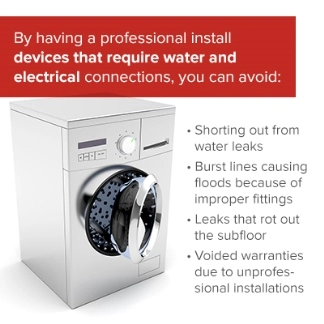
Installing or servicing appliances that require both water and electricity connections is best left to those who are trained and qualified. Dishwashers, water heaters and even washing machine hookups can be seen as easy projects for the competent DIY-er, and there have been many successful installations from motivated homeowners. The reason this is considered a project best left to licensed professionals is the possibility of issues that may not be noticed by the untrained. It’s not too difficult to install a dishwasher or washing machine using existing connections, but it is definitely advisable to have a professional plumber set up the intake and discharge lines. They will be able to determine the ideal connection for your water supply and be sure any potential leaks won’t be in direct contact with sources of electricity.
In some cases, improper connections have resulted in:
- the dishwasher shorting out from water leaks.
- major floods from lines bursting because of improper fittings.
- unnoticeable leaks that rot out the subfloor.
- voided warranties due to unprofessional installations.
2. Bathroom and Kitchen Makeovers/Installation of New Pipes, Sinks or Tubs
The minor work of installing a toilet or new faucets is simple enough if you’re up for it, but once you need work done on pipes or tub and shower installations, or a new fixture needs re-plumbing, a professional will give you the worry-free work you’ll be glad to pay for. Keep in mind that any plumbing you won’t see after the work is done is the work you don’t want to do yourself. While installing a tub to existing connections may seem easy enough, you don’t know if you’ll be able to deal with any situation you may uncover.
Plumbers aren’t just trained on how to form and install new plumbing — they’re also trained to notice any potential problems with what’s been uncovered. They can deal with any complicated issues on the spot. Licensed plumbers have the knowledge to run the new plumbing in any situation and the specialty tools and equipment to get the job done right.
3. Sewer Lines and Septic Systems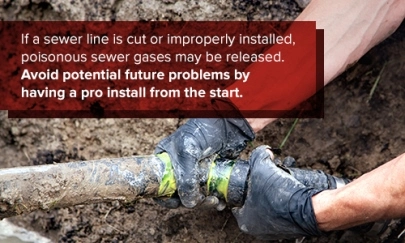
This is probably one area of plumbing the least amount of homeowners are willing to deal with themselves. It likely has a lot to do with the contents of sewer lines and septic systems, but the poisonous gases that can be released inside the home from improper plumbing are a serious safety hazard that should not be dealt with by the untrained.
If a line was accidentally cut or a vital seal was not installed properly, sewer gases may not even be noticeable. The potential mess is also something that any homeowner or plumbing professional doesn’t want to clean up, so handle projects that deal with your sewer lines and septic systems the right way and get a pro from the start.
6 Common Plumbing Problems You Can Probably Fix Yourself
Now that you’re armed with the right information about maintaining your plumbing system, preventing common plumbing issues and knowing when to call in the professionals, here are a few plumbing problems you can safely do yourself with a bit of common sense and a little mechanical aptitude.
1. Running Toilets
The most common cause of toilets that won’t stop running water into the bowl is a faulty flapper valve. This valve allows the water to pass from the tank to the bowl and eventually wears out from use. Toilet repair kits are readily available and are manufactured for nearly all types of toilets. They come with easy-to-follow instructions, and you won’t even have to put aside much time for the replacement. Remember to turn off the water to the toilet — you can usually find the valve at the back under the tank of the toilet.
If you’ve changed the inner workings of your toilet and it’s still running, you may have an issue with sediment buildup that needs the attention of a professional.
2. No Hot Water or Water Doesn’t Get Hot Enough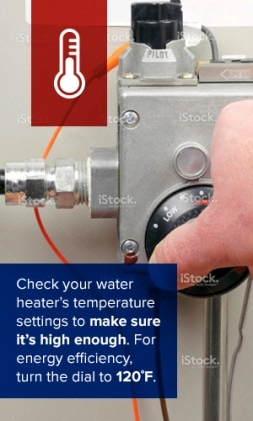
While we mentioned water heater installation and service earlier as “professionals only” fixes, there are a few simple things you can check on to get a better idea of what the issue with your water heater may be. Whenever you’re not comfortable or unsure of what you’re doing around a water heater, hire a plumber for a worry-free repair.
If you have a gas water heater, check to see if the pilot light is on. Most water heaters have lighting instructions on the unit. If you are unsure about why the pilot is not lit or just aren’t comfortable investigating it, call in a plumber, even if it’s just for peace of mind.
If you’re in a new home, check the temperature setting on your water heater to see if it’s set high enough. The U.S. Department of Energy recommends setting your water heater to 120 degrees Fahrenheit for energy efficiency, compared to the default setting of 140 degrees Fahrenheit set by most manufacturers.
Could the hot water tank be too small for the demands of your household? You may need a bigger hot water heater or you may have to spread out the use of hot water if you find you’re without hot water sporadically. Having a hot water tank installed is definitely a job for a professional, so give us a call at Mr. Rooter Plumbing in Oneida for help with making the best choice for your hot water needs.
3. Low Water Pressure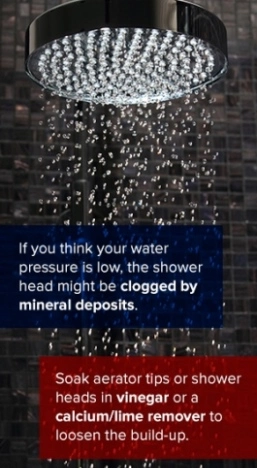
Especially disappointing in the shower, low water pressure can affect any fixture in your house. Most issues of low water pressure from certain fixtures are probably due to hard water deposits on the aerator of the faucet or shower head. If you have a regular problem with mineral deposits, you may want to consider having a filtration system installed to remove these minerals from the water coming into your house. Removable aerator tips and shower heads can be soaked in vinegar or a commercial calcium and lime remover for a few hours. You can also attach a bag filled with vinegar or a commercial solution to a faucet or shower head for several hours to eat away at the buildup.
You may be faced with a more complex issue if removing the buildup doesn’t fix the problem. If you have a sudden or significant reduction in water pressure, this would be a problem for a plumber to investigate.
4. Dripping Faucets
Once you’ve ensured that the dripping isn’t due to the tap not being closed all the way, you can assume the issue has to do with the rubber or silicone-based washer or ceramic plates that create a water-tight seal in your fixture. All the water in your home is under pressure to help it flow through your pipes, and every fixture is equipped with these washers or plates to create that tight seal after the tap is turned off.
One in ten homes in the U.S. has leaks that can waste 90 or more gallons of water. Most of these leaks can be easily repaired by replacing fixtures or parts. Fixing minor household water leaks can save an estimated 10% on your water bill. Even if you pay a plumber to fix the dripping faucet, you will still be saving yourself money in the long run.
5. Malfunctioning Garbage Disposals
Any complicated issues with your garbage disposal should be looked at by a professional, but a minor issue can be resolved by the regular maintenance task of running cold water into the unit.
6. Should You Install Your Own Fixture or Toilet?
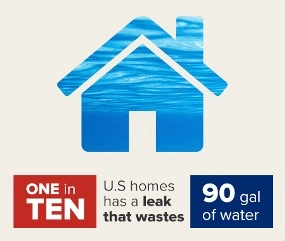 Installing a toilet can be an achievable do-it-yourself project, but there are a few things to keep in mind. The wax seal is the most important part of the installation — or more specifically, installing the wax seal properly is the most important part. The new toilet will come with instructions that you can refer to, so we won’t describe the step-by-step process. You can also get some help through professional how-to videos. If you’re mechanically inclined, have some basic plumbing knowledge, and can fit that wax seal with care, then you should be successful at installing your own toilet.
Installing a toilet can be an achievable do-it-yourself project, but there are a few things to keep in mind. The wax seal is the most important part of the installation — or more specifically, installing the wax seal properly is the most important part. The new toilet will come with instructions that you can refer to, so we won’t describe the step-by-step process. You can also get some help through professional how-to videos. If you’re mechanically inclined, have some basic plumbing knowledge, and can fit that wax seal with care, then you should be successful at installing your own toilet.
The same general recommendations apply to installing your own fixtures, but depending on your skill level, you may want to call a professional if the holes for the new fixture don’t line up with the old ones or if you’re looking at installing some of the high-quality fixtures with various components to figure out. The basic household fixtures are pretty easy to install for the competent homeowner.
We’re Just a Call Away to Help With Your Plumbing Needs
Whether you’ve got a major plumbing project planned, you don’t have the time to do minor tasks like fix that running toilet or you have any emergency you need looked at right away, we’re ready to take your call and get one of our licensed plumbers out to your home to get the job done right and with minimal disruptions. Contact Mr. Rooter in Oneida for any of your plumbing needs.

